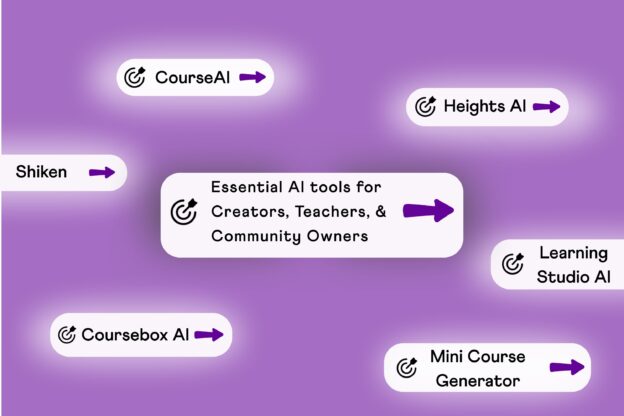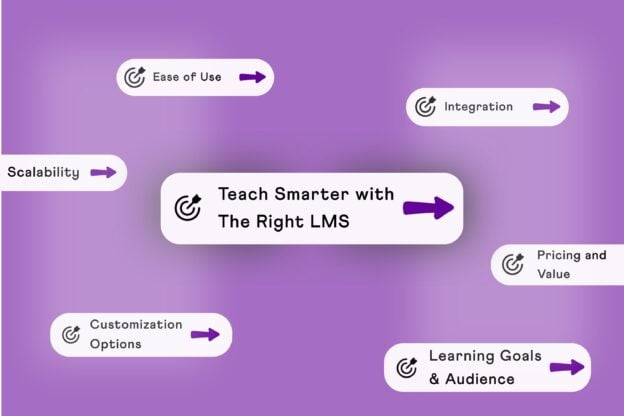What makes a good online course?
In the past, creating courses was something few people did. With little effort, you could get many learners to buy your course and make a large figure in revenue. Now almost anyone can create a course. This has become so common that you must know how to make your courses stand out to generate enough revenue for all your hard work.
So for this post, we will look at course features you need to consider to make a 6 figure course. Knowing HOW to remain unique is important because it will allow you to gain and retain your existing learners to keep buying courses on your site.
Let’s look at the course features you need to address to make 6-figures from your courses.
What Makes a Good Online Course?
There are many factors to consider when creating your course. We have listed a total of 10 features you need to have in your course. Let’s look at the first one.
1. Having High-Quality Content
Having high-quality content is one of the best practices for online courses. There are several ways you can do this. You can create YouTube videos on the niche area of your course. Then you can link your paid courses in the description on your Youtube videos. The image below shows a YouTube video with links to the paid course on the main website.
Besides creating content on YouTube, you can also create content for your course through blogging, social media, emails, and even through your own mobile app.
Just remember that the content should cover topics accurately, with up-to-date and relevant information. It should be well-researched and presented in a clear, concise manner.
You do not need to go into the details of the content. Just talk about the basics and then at the end of the video or any content media, encourage your users to visit your website for the full course. This strategy will lead to the sale of your course.
2. Engaging and Interactive Delivery
A 6 figure course should be highly interactive and engaging for your audience. Your tone should be friendly as you speak to your audience. If you are showing yourself fully, wear a proper outfit. Wearing a shirt with your brand’s logo and a pair of pants is a common way to present a course. There are no rules for this but you need to look professional.
You also need to be open to comments made to your course and respond where needed. This means you will need to invite them to comment if they need help. Being open to helping your learners is a valuable quality of your course.
And don’t forget about your content, always use multimedia elements like videos, animations, and interactive quizzes to make learning more engaging. Interactive elements keep learners interested and help in better retention of the material.
3. Expert Instruction Certification
Although this is not needed at all, having a formal certification is what makes a good online course valid and authentic.
For example, if your course is on health and fitness and you have a certification in nutrition or a fitness course, then your course will be more valid and authentic in your learners’ eyes.
Below is an example of an instructor who is stating who she is by describing her experience. You can also state your university degree if you think it is relevant.
Having a formal certification will show that you as an instructor are knowledgeable and experienced in the field of interest. It shows you can convey information effectively and be approachable for queries and discussions.
4. Structured Yet Flexible Curriculum
Setting the right curriculum for a course involves a systematic and thoughtful process that aligns educational content with learning objectives, and assessment methods.
It’s important to understand the background and needs of the student audience to tailor the content effectively. This involves selecting relevant and diverse topics, designing teaching methods that cater to various learning styles, and planning assessment strategies that accurately measure progress.
The curriculum should be logically sequenced, starting with foundational concepts and gradually increasing in complexity.
We have a full post on how to set a course outline. Feel free to check out this post. It is the first step to setting the course curriculum of your first course.
5. Practical Application to Reflect the Real-World
The course should include practical, real-world applications. Case studies, simulations, and projects that allow learners to apply what they have learned can greatly enhance the learning experience.
The incorporation of practical applications in a course is crucial as it bridges the gap between theoretical knowledge and real-world skills. For example, in a computer science course, students might engage in coding projects that solve actual problems, allowing them to apply programming concepts in a hands-on manner.
In a business course, case studies and simulations can provide students with insights into real business challenges and decision-making processes.
These practical elements not only enhance understanding and retention of your course material but also help make your course more valuable in terms of a 6-figure course experience.
6. Interactivity and Community Building
Your 6-figure course continues after publication. You must remain alert for comments and any confusion that may arise as a result of your course.
If you have a large pool of learners, it can be hard to keep up with so many users. The best way to manage and interact with your users is to use a membership community.
There are many membership communities such as Facebook, Mighty Network, Podia, and so on.
But if you are looking for a facility that will create a separate website for your courses and your mobile app then BuddyBoss’s membership platform will be a perfect package as it will make it easier to retain the qualities of a 60-figure coaching business.
The BuddyBoss membership platform has features such as discussion forums, group projects, and peer reviews that encourage interaction among learners and foster a sense of community.
7. Assessment and Feedback
Assessment and feedback are integral to creating a quality course for both evaluating student performance and enhancing the learning experience.
Assessments, whether formative (like quizzes and assignments) or summative (like final exams and projects), allow instructors to gauge students’ understanding of the material, providing a measure of how well the course objectives are being met.
They also give students a clear indication of their progress, highlighting areas of strength and those needing improvement. Feedback, on the other hand, is crucial for learning and development.
Timely, constructive feedback helps students internalize lessons, correct misunderstandings, and apply knowledge more effectively. It also serves as a two-way communication channel, where students can express their learning needs or challenges, enabling instructors to adjust the course content, and assessments accordingly.
8. Accessibility and User-Friendly Design
The course should be accessible to a wide range of learners. This is what makes a good online course because a course that is easily accessible will focus on making course materials and activities usable for individuals with a wide range of abilities, including those with disabilities.
This might involve providing alternative text for images, captioning videos, or ensuring compatibility with screen readers. These measures also broaden the reach of the course to a diverse audience.
On the other hand, user-friendly design pertains to the overall ease of use and navigation of the course. It includes having a clear, intuitive layout, consistent structure, and straightforward instructions. This is crucial in reducing cognitive load and allowing students to focus on learning rather than figuring out how to use the course.
9. Technical Support and Resources
Reliable technical support ensures that both instructors and students can smoothly navigate and utilize various learning platforms and tools, minimizing disruptions due to technical glitches. This support ranges from troubleshooting common issues to offering guidance on how to effectively use digital resources. Additionally, providing a range of quality resources, such as online libraries, software, and multimedia content, enriches the learning experience. Additional learning resources like supplementary readings, external links, and downloadable materials add value.
These resources allow students to access a wide array of information and tools, facilitating diverse learning styles and enhancing their ability to research and apply knowledge.
Below is an example of a popular learning platform called AmigosCode, which uses a vast resource to guide its students. As you can see, they have additional resources for AWS(Amazon web services), DevOps, and so on. AmigosCode is a very mature course platform that makes more than 6-figures. However, once you can make more through your courses, you will be able to hire more people to scale your coaching business through more courses with extra resources.
The Secret to Maintaining Your Course Quality
When it comes to considering what makes a good online course, there is a lot that needs to be done to ensure your course is making 6 figures. All the factors described above must be automated with an online system to manage your courses. This will also lead to the branding of your course. Only then will you be able to make the desired amount.
However, it is not possible to do all this on your own. Creating a course site, with a mobile app, and then having a membership community on the same site is something that will need help.
Fortunately, this is all possible when using the BuddyBoss platform.
The BuddyBoss platform will automatically set up your course site, mobile app, and membership community at the same time. Just install and start creating your course right away. You can also look at the demo site of the BuddyBoss platform if you want to try it out before making your decision.
FAQ on What Makes a Good Online Course?
1. How long should an online course be?
Generally, online courses should be concise enough to maintain student engagement and prevent cognitive overload, yet comprehensive enough to cover the necessary content.
For in-depth topics, a duration of 4 to 12 weeks with manageable weekly modules is common. Each module might include 1-3 hours of learning material per week. But make sure to balance video lectures, readings, and interactive elements. This is what makes a good online course.
Shorter courses, often called microlearning courses, can range from a few minutes to a couple of hours, focusing on very specific skills or topics. These are ideal for busy learners or for topics requiring minimal time commitment.
2. What are some Best Practices for Online Courses?
Many of the best practices have been listed above in this post. But the best practices for online courses center around creating an engaging, accessible, and effective learning experience. Course content should be well-structured and presented in digestible modules, incorporating a mix of multimedia elements like videos, readings, and interactive activities to cater to different learning styles. Remember that, clear learning objectives and regular assessments help keep students on track.
Lastly, instructor presence is vital; responsive and engaging instructors can greatly enhance the learning experience, making the course feel more personal and less isolated. These practices contribute to a more fulfilling and effective online learning environment.
3. Can I modify the course content after the course has been completed?
Yes of course! It’s important to be flexible. You can make modifications based on student feedback, engagement levels, and evolving educational needs.
Courses that are updated with the latest developments are what makes a good online course more useful to a user because it eliminates the need for a user to start a new course from scratch or look for a completely new course elsewhere.
By the way, if you do update your course, be sure to mention this with the date and add a relevant title to make the course stand out more.
4. How do I measure the success of my course?
You can measure the success of your course through student outcomes, feedback, engagement metrics, and assessment results. Also, regular evaluations and updates can help improve course effectiveness.
5. Should I upload my courses on Udemy or have my website with my courses?
It is better to own a website that lists all your courses. This eliminates competition from other courses as Udemy lists courses from other instructors. They also rank only highly rated courses on their site. So if you are new to the Udemy website, you face fewer chances for ranking and making a 6-figure on your website.
However, if you own your own site by using the BuddyBoss platform, you get a complete package such as a membership platform, a course website, and a mobile app with all your courses. A course site that has these qualities is what makes a good online course that will eventually make 6-figures.
All this is not possible by using Udemy. In addition, marketing for your course site will spill more fruitful results as there are no competitors on your course site website.
Conclusion
As you can see, course creation is a long process that is rewarding in the long run. But if you are looking to speed up your figures, then it is important to automate your process that will reflect a branded course and not just any courses. You also want your course to be available on a mobile device to boost your chances for success.
In addition, you also want a membership community that will include your followers and learners. Don’t forget about the other qualities described above as these are what makes a good online course.
Lastly, if you are still in doubt then have a look at the image below of people who are making 6-figures by using the BuddyBoss platform for their course-based business.











